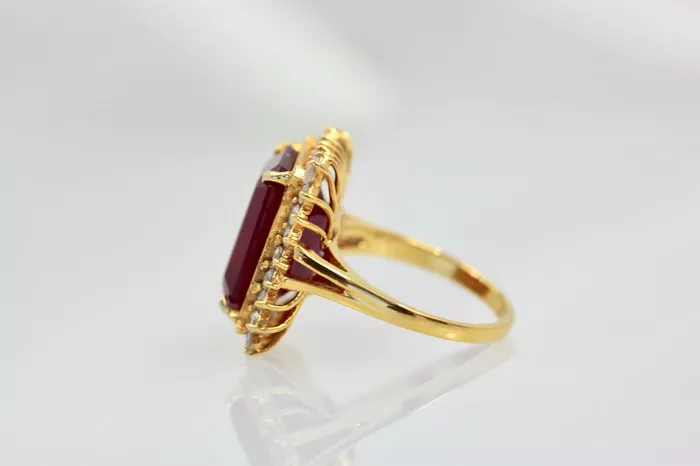When it comes to purchasing or inheriting a ring, especially one adorned with precious stones like diamonds, ensuring its authenticity is paramount. Counterfeit gems have flooded the market, making it increasingly challenging for consumers to differentiate between real and fake stones. Fortunately, there are several methods you can employ to verify the authenticity of your ring. In this guide, we will explore various techniques, including the Dot Test, Water Test, Fog Test, Scratch Test, and considerations regarding the setting and mount. Additionally, we’ll emphasize the importance of seeking professional appraisal to obtain a conclusive assessment.
The Dot Test
The Dot Test serves as a preliminary examination to discern the authenticity of a gemstone, particularly diamonds. To perform this test, you’ll need a white piece of paper and a pen. Begin by placing the paper on a flat surface and drawing a small dot with the pen. Then, carefully lay the stone, typically the ring, onto the dot.
Observe the reflection within the gemstone. A genuine diamond will refract light in such a way that the dot is not visible through the stone. Conversely, if you notice a circular reflection resembling the dot, it’s likely that the stone is fake. This phenomenon occurs because counterfeit stones often have facets or internal characteristics that cause light to bounce differently compared to authentic diamonds.
Water Test
The Water Test is another simple yet effective method to determine the authenticity of a diamond ring. For this test, you’ll need a glass filled with water. Hold the ring by its band and gently drop the stone into the water.
Observe the behavior of the stone in the water. A real diamond, owing to its high density, will sink straight to the bottom without hesitation. In contrast, fake stones may float or take longer to descend due to their lower density. This discrepancy in buoyancy provides a reliable indication of the diamond’s authenticity.
Fog Test
The Fog Test is a quick and convenient way to assess the thermal conductivity of a diamond. Hold the ring between two fingers and breathe on it to create fog. Pay close attention to how the fog dissipates.
If the fog disperses rapidly and uniformly across the surface of the stone, it’s likely a real diamond. Authentic diamonds possess high thermal conductivity, meaning they quickly disperse heat and, consequently, fog. On the other hand, if the fog lingers or dissipates slowly, it suggests that the stone is fake. Counterfeit diamonds typically lack the same level of thermal conductivity as genuine ones.
Scratch Test
While not definitive, the Scratch Test can offer valuable insights into the hardness of a stone, which is a characteristic of diamonds. To conduct this test, you’ll need a magnifying glass to examine the surface of the stone closely.
Inspect the stone for any scratches or abrasions. Genuine diamonds are exceptionally hard and resistant to scratching, scoring a perfect 10 on the Mohs scale of mineral hardness. If the stone exhibits scratches or signs of wear under magnification, it’s likely not a real diamond. However, exercise caution when performing this test, as scratching the surface of a genuine diamond could damage it.
Setting & Mount
In addition to the characteristics of the stone itself, the setting and mount of the ring can also provide clues about its authenticity. Genuine diamonds are typically set in high-quality materials such as gold, platinum, or high-grade silver.
Examine the setting closely for signs of craftsmanship and durability. A cheap or poorly constructed setting may indicate that the stone is not genuine. Additionally, inspect the prongs holding the stone in place. Loose or uneven prongs could suggest that the stone is fake or of low quality.
Seek Professional Appraisal
While the aforementioned tests can offer valuable insights, it’s essential to acknowledge their limitations. No single at-home test can provide a definitive assessment of a diamond’s authenticity. Factors such as lighting conditions, environmental variables, and the specific characteristics of the stone can all influence the results of these tests.
For a conclusive evaluation, it’s advisable to seek the expertise of a professional gemologist or appraiser. These individuals possess the knowledge, experience, and specialized equipment necessary to accurately assess the authenticity and value of a diamond ring. A professional appraisal not only provides peace of mind but also ensures that you are making an informed decision regarding your precious investment.
In conclusion, determining the authenticity of your ring requires a combination of observation, experimentation, and expert analysis. By utilizing techniques such as the Dot Test, Water Test, Fog Test, and Scratch Test, along with careful consideration of the setting and mount, you can gain valuable insights into the nature of the stone. However, for a definitive assessment, always consult a qualified professional who can provide an expert evaluation tailored to your specific needs and concerns.

